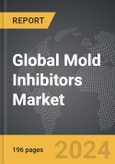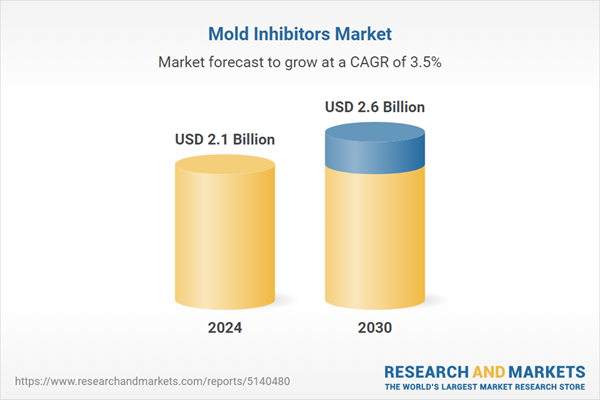The global market for Mold Inhibitors was valued at US$2.1 Billion in 2024 and is projected to reach US$2.6 Billion by 2030, growing at a CAGR of 3.5% from 2024 to 2030. This comprehensive report provides an in-depth analysis of market trends, drivers, and forecasts, helping you make informed business decisions. The report includes the most recent global tariff developments and how they impact the Mold Inhibitors market.
Segments: Type (Propionates, Benzoates, Natamycin, Sorbates, Other Types); Application (Food, Animal Feed, Paints, Pharmaceuticals, Cosmetics & Personal Care, Other Applications).
Geographic Regions/Countries: World; United States; Canada; Japan; China; Europe (France; Germany; Italy; United Kingdom; Spain; Russia; and Rest of Europe); Asia-Pacific (Australia; India; South Korea; and Rest of Asia-Pacific); Latin America (Argentina; Brazil; Mexico; and Rest of Latin America); Middle East (Iran; Israel; Saudi Arabia; United Arab Emirates; and Rest of Middle East); and Africa.
The analysts continuously track trade developments worldwide, drawing insights from leading global economists and over 200 industry and policy institutions, including think tanks, trade organizations, and national economic advisory bodies. This intelligence is integrated into forecasting models to provide timely, data-driven analysis of emerging risks and opportunities.
Global Mold Inhibitors Market - Key Trends & Drivers Summarized
What Are Mold Inhibitors and Why Are They Essential?
Mold inhibitors are chemicals or natural compounds used to prevent the growth of mold and yeast in various products, extending their shelf life and ensuring safety and quality. Commonly used in the food and beverage industry, these inhibitors are crucial in bread, dairy products, meats, and other perishables. Beyond food, they are also prevalent in industries like pharmaceuticals, cosmetics, animal feed, and construction, where they protect materials from spoilage and decay due to mold contamination. Mold inhibitors work by disrupting the life cycle of mold spores, preventing them from reproducing and spreading. This role is vital in maintaining the structural integrity and aesthetic value of products, making mold inhibitors integral to quality control processes.How Are Advancements in Science Enhancing Mold Inhibition Techniques?
Scientific advancements are significantly enhancing the efficacy and application spectrum of mold inhibitors. The development of more sophisticated synthetic and natural inhibitors is driven by an increased understanding of mold biology and its interaction with various environments. Innovations such as encapsulation technology improve the delivery and longevity of mold-inhibiting actions in products. Moreover, the integration of IoT technology in monitoring systems allows real-time tracking of conditions conducive to mold growth, facilitating proactive management. These advancements not only expand the potential applications of mold inhibitors in traditional industries but also offer new opportunities in sectors concerned with material longevity and biostability.What Trends Are Influencing the Demand for Mold Inhibitors Across Industries?
The demand for mold inhibitors is shaped by several industry trends emphasizing health, safety, and sustainability. In the food sector, increasing consumer awareness about foodborne illnesses and a greater preference for fresh, longer-lasting products drive the need for effective mold prevention solutions. Regulatory pressures and standards worldwide are also tightening, requiring manufacturers to adopt safe and efficient preservation methods. In construction and textiles, the push towards green building materials and durable fabrics respectively calls for mold inhibitors that are environmentally friendly and less reliant on harsh chemicals, aligning with global sustainability goals.What Drives the Growth in the Mold Inhibitors Market?
The growth in the mold inhibitors market is driven by several factors, reflecting diverse technological, regulatory, and consumer-based influences. Technological innovations that allow for more effective and targeted mold prevention are critical growth drivers, as they cater to industry demands for efficiency and efficacy. Regulatory developments that mandate stricter safety and quality standards propel the adoption of these inhibitors, particularly in food processing and packaging. Consumer trends towards healthier and safer products also fuel growth, as end-users increasingly seek products with extended shelf life but without the use of traditional preservatives. Additionally, the expansion of industries like pharmaceuticals and personal care into more humid and mold-prone regions necessitates robust mold prevention strategies, further bolstering the market. These factors collectively drive the continued relevance and expansion of the mold inhibitors market, highlighting its crucial role in modern manufacturing and product development.Report Scope
The report analyzes the Mold Inhibitors market, presented in terms of units. The analysis covers the key segments and geographic regions outlined below.Segments: Type (Propionates, Benzoates, Natamycin, Sorbates, Other Types); Application (Food, Animal Feed, Paints, Pharmaceuticals, Cosmetics & Personal Care, Other Applications).
Geographic Regions/Countries: World; United States; Canada; Japan; China; Europe (France; Germany; Italy; United Kingdom; Spain; Russia; and Rest of Europe); Asia-Pacific (Australia; India; South Korea; and Rest of Asia-Pacific); Latin America (Argentina; Brazil; Mexico; and Rest of Latin America); Middle East (Iran; Israel; Saudi Arabia; United Arab Emirates; and Rest of Middle East); and Africa.
Key Insights:
- Market Growth: Understand the significant growth trajectory of the Propionates segment, which is expected to reach US$960.3 Million by 2030 with a CAGR of a 4.2%. The Benzoates segment is also set to grow at 3.5% CAGR over the analysis period.
- Regional Analysis: Gain insights into the U.S. market, valued at $559.7 Million in 2024, and China, forecasted to grow at an impressive 5.4% CAGR to reach $534.9 Million by 2030. Discover growth trends in other key regions, including Japan, Canada, Germany, and the Asia-Pacific.
Why You Should Buy This Report:
- Detailed Market Analysis: Access a thorough analysis of the Global Mold Inhibitors Market, covering all major geographic regions and market segments.
- Competitive Insights: Get an overview of the competitive landscape, including the market presence of major players across different geographies.
- Future Trends and Drivers: Understand the key trends and drivers shaping the future of the Global Mold Inhibitors Market.
- Actionable Insights: Benefit from actionable insights that can help you identify new revenue opportunities and make strategic business decisions.
Key Questions Answered:
- How is the Global Mold Inhibitors Market expected to evolve by 2030?
- What are the main drivers and restraints affecting the market?
- Which market segments will grow the most over the forecast period?
- How will market shares for different regions and segments change by 2030?
- Who are the leading players in the market, and what are their prospects?
Report Features:
- Comprehensive Market Data: Independent analysis of annual sales and market forecasts in US$ Million from 2024 to 2030.
- In-Depth Regional Analysis: Detailed insights into key markets, including the U.S., China, Japan, Canada, Europe, Asia-Pacific, Latin America, Middle East, and Africa.
- Company Profiles: Coverage of players such as Archer Daniels Midland Company, Associated British Foods PLC, BASF SE, Dow, Inc., DuPont de Nemours, Inc. and more.
- Complimentary Updates: Receive free report updates for one year to keep you informed of the latest market developments.
Some of the 46 companies featured in this Mold Inhibitors market report include:
- Archer Daniels Midland Company
- Associated British Foods PLC
- BASF SE
- Dow, Inc.
- DuPont de Nemours, Inc.
- Eastman Chemical Company
- Handary SA
- Hawkins Watts Limited
- Kemin Industries, Inc.
- Koninklijke DSM NV
- Niacet Corporation
- Pacific Coast Chemical Co.
Tariff Impact Analysis: Key Insights for 2025
Global tariff negotiations across 180+ countries are reshaping supply chains, costs, and competitiveness. This report reflects the latest developments as of April 2025 and incorporates forward-looking insights into the market outlook.The analysts continuously track trade developments worldwide, drawing insights from leading global economists and over 200 industry and policy institutions, including think tanks, trade organizations, and national economic advisory bodies. This intelligence is integrated into forecasting models to provide timely, data-driven analysis of emerging risks and opportunities.
What’s Included in This Edition:
- Tariff-adjusted market forecasts by region and segment
- Analysis of cost and supply chain implications by sourcing and trade exposure
- Strategic insights into geographic shifts
Buyers receive a free July 2025 update with:
- Finalized tariff impacts and new trade agreement effects
- Updated projections reflecting global sourcing and cost shifts
- Expanded country-specific coverage across the industry
Table of Contents
I. METHODOLOGYII. EXECUTIVE SUMMARY2. FOCUS ON SELECT PLAYERSIII. MARKET ANALYSISCANADAITALYSPAINRUSSIAREST OF EUROPESOUTH KOREAREST OF ASIA-PACIFICARGENTINABRAZILMEXICOREST OF LATIN AMERICAIRANISRAELSAUDI ARABIAUNITED ARAB EMIRATESREST OF MIDDLE EASTIV. COMPETITION
1. MARKET OVERVIEW
3. MARKET TRENDS & DRIVERS
4. GLOBAL MARKET PERSPECTIVE
UNITED STATES
JAPAN
CHINA
EUROPE
FRANCE
GERMANY
UNITED KINGDOM
ASIA-PACIFIC
AUSTRALIA
INDIA
LATIN AMERICA
MIDDLE EAST
AFRICA
Companies Mentioned (Partial List)
A selection of companies mentioned in this report includes, but is not limited to:
- Archer Daniels Midland Company
- Associated British Foods PLC
- BASF SE
- Dow, Inc.
- DuPont de Nemours, Inc.
- Eastman Chemical Company
- Handary SA
- Hawkins Watts Limited
- Kemin Industries, Inc.
- Koninklijke DSM NV
- Niacet Corporation
- Pacific Coast Chemical Co.
Table Information
| Report Attribute | Details |
|---|---|
| No. of Pages | 196 |
| Published | April 2025 |
| Forecast Period | 2024 - 2030 |
| Estimated Market Value ( USD | $ 2.1 Billion |
| Forecasted Market Value ( USD | $ 2.6 Billion |
| Compound Annual Growth Rate | 3.5% |
| Regions Covered | Global |









